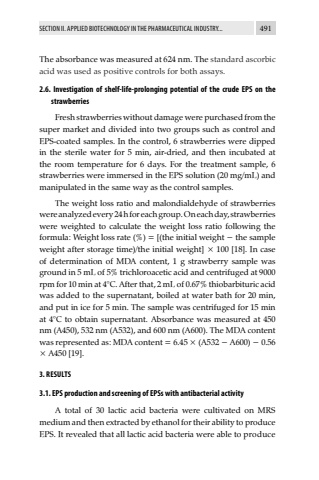Page 487 - Demo
P. 487
SECTION II. APPLIED BIOTECHNOLOGY IN THE PHARMACEUTICAL INDUSTRY... 491The absorbance was measured at 624 nm. The standard ascorbic acid was used as positive controls for both assays.2.6. Investigation of shelf-life-prolonging potential of the crude EPS on the strawberriesFresh strawberries without damage were purchased from the super market and divided into two groups such as control and EPS-coated samples. In the control, 6 strawberries were dipped in the sterile water for 5 min, air-dried, and then incubated at the room temperature for 6 days. For the treatment sample, 6 strawberries were immersed in the EPS solution (20 mg/mL) and manipulated in the same way as the control samples.The weight loss ratio and malondialdehyde of strawberrieswere analyzed every 24 h for each group. On each day, strawberries were weighted to calculate the weight loss ratio following the formula: Weight loss rate (%) = [(the initial weight %u2212 the sample weight after storage time)/the initial weight] %u00d7 100 [18]. In case of determination of MDA content, 1 g strawberry sample was ground in 5 mL of 5% trichloroacetic acid and centrifuged at 9000 rpm for 10 min at 4%u00b0C. After that, 2 mL of 0.67% thiobarbituric acid was added to the supernatant, boiled at water bath for 20 min, and put in ice for 5 min. The sample was centrifuged for 15 min at 4%u00b0C to obtain supernatant. Absorbance was measured at 450 nm (A450), 532 nm (A532), and 600 nm (A600). The MDA content was represented as: MDA content = 6.45 %u00d7 (A532 %u2212 A600) %u2212 0.56 %u00d7 A450 [19].3. RESULTS3.1. EPS production and screening of EPSs with antibacterial activityA total of 30 lactic acid bacteria were cultivated on MRS medium and then extracted by ethanol for their ability to produce EPS. It revealed that all lactic acid bacteria were able to produce


